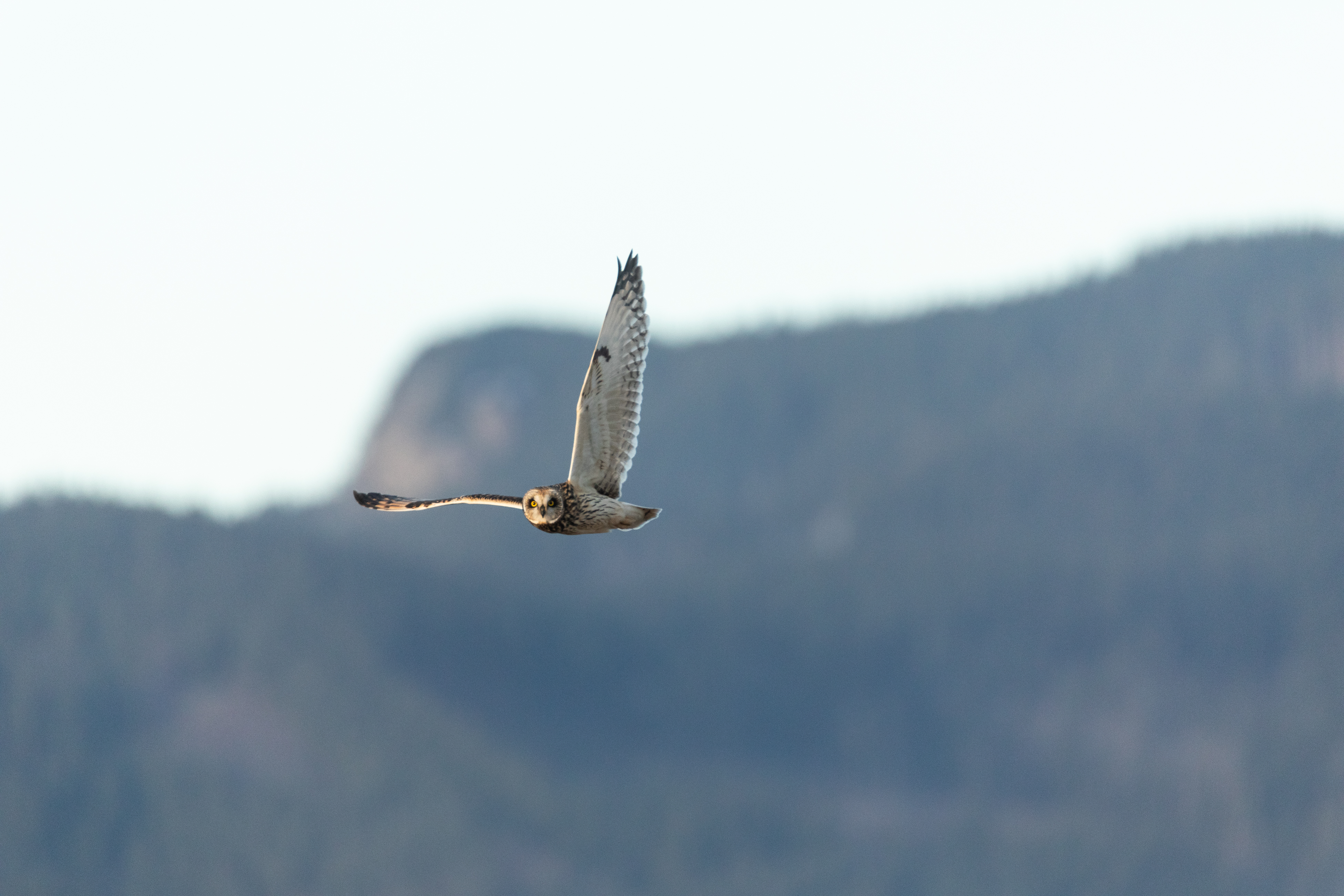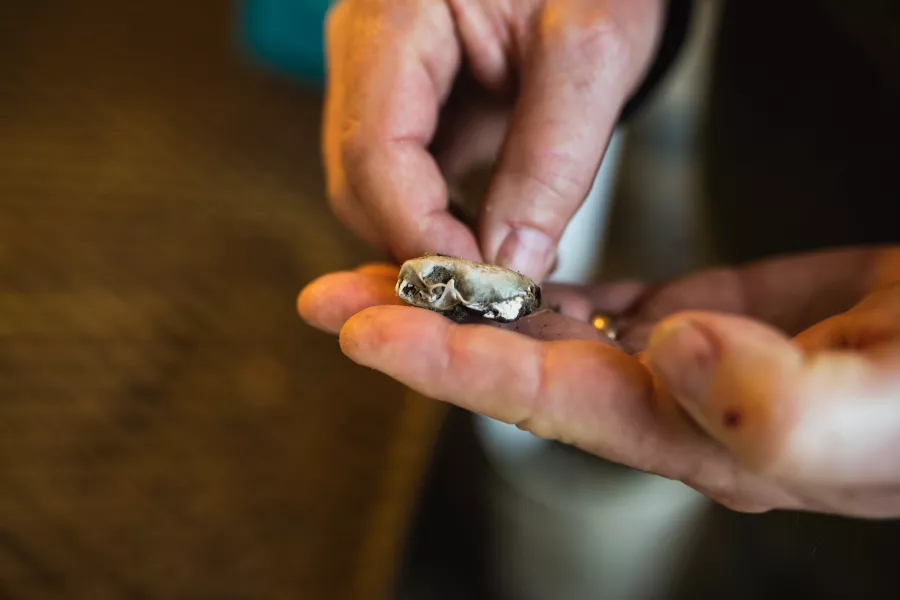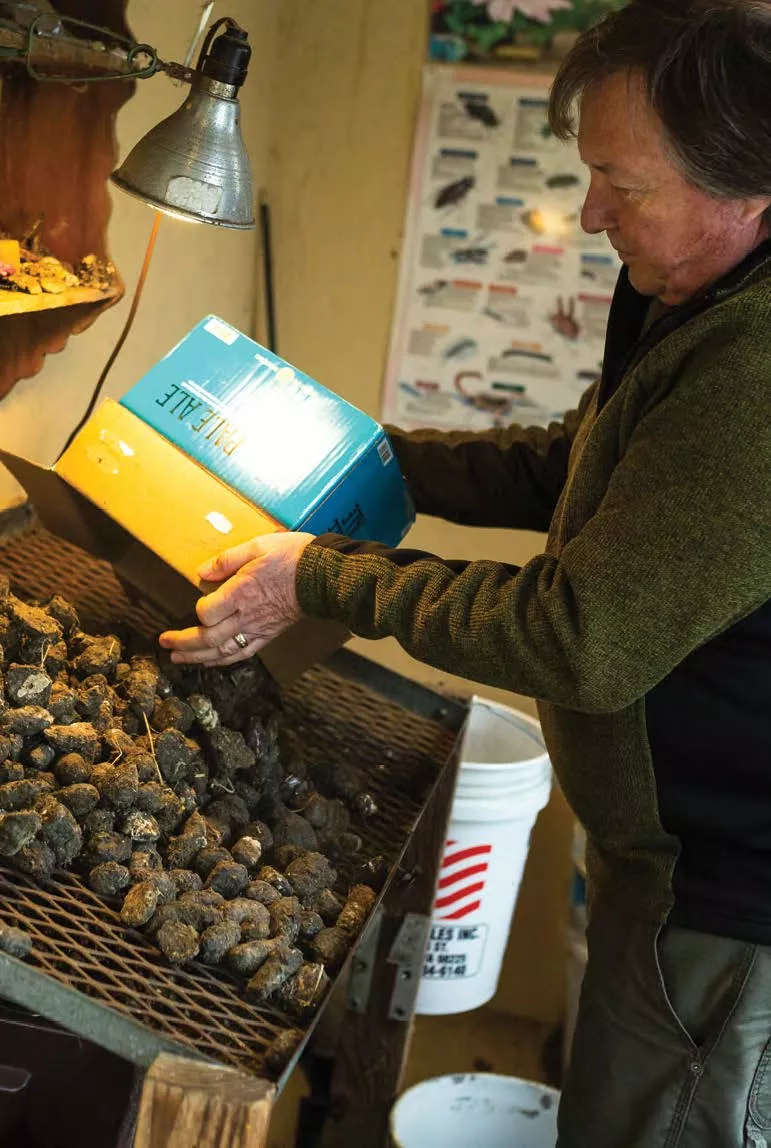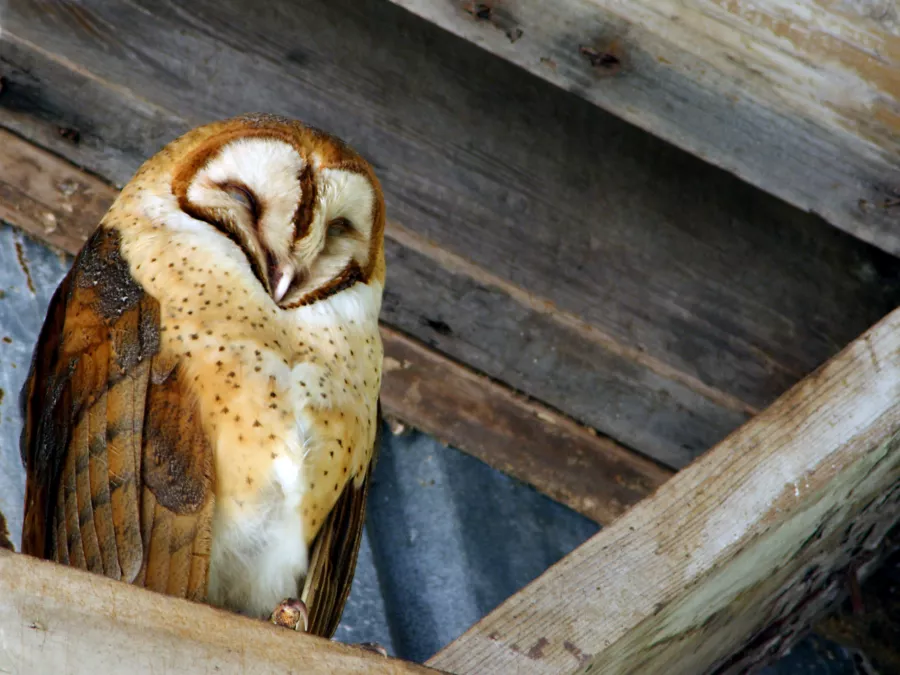"They look like fecal material. They’re blackish and roundish. They crunch when you step on them because they have these skeletons inside them.”
Bret Gaussoin, ’84, is describing the small, scat-like packages that he and his wife Kim, ’83, make their living from: barn owl pellets.
The pellets are the regurgitated remains of the barn owl’s dinner. Due to a weak digestive system and the owl’s propensity for swallowing its prey whole, barn owls cough up something akin to a hairball, filled with fur and bones, often containing two or three different skeletons.
While all birds of prey, along with ravens and shorebirds, produce pellets of undigested remains, barn owl pellets are special.
“That owl swallows that thing whole and can’t digest any bone whatsoever— none. And it makes this perfect little dissection product.”
The pellets’ value as an easy-to-dissect package makes them a hot commodity for school district and summer camp science projects, and today the Gaussoins estimate their company, Pellets, Inc., is the largest supplier of owl pellets in the country.
Bret got his start in the pellet game as a student, helping Western Professor of Biology Irwin Slesnick collect the pellets for his burgeoning business, which Bret and Kim would later buy.
It started with a pile of pellets
Slesnick was a pioneer in the pellet industry in the 1970s and ’80s—today many large educational supply houses carry them. It was an idea that came to Slesnick when he moved to Bellingham from the East Coast and he realized how many barns, and barn owls, were to be found in Whatcom and Skagit counties, Bret says.
It was while wandering the halls of the Biology Department that Bret discovered that “Sles” was looking for these precious pellets.
Bret says he was an enthusiastic student with just one thing on his mind: learning all he could about birds of prey, especially hawks and falcons. He even took up falconry for a few decades.
“That’s how I ended up finding my first batch of pellets. I was out here around Ferndale tromping through the woods looking for a Cooper’s hawk nest and I found this pile of pellets. I took them in to Sles, I knew he was into them, and that’s where it all started.”
Slesnick spent 33 years in Western’s Biology Department and was passionate about science education, a force behind the Science Math and Technology Education program, better known as SMATE. Western’s annual STEM Education Symposium is named in his memory.
Bret, who earned his bachelor’s degree in biology, never did take a class from Slesnick. It was through collecting pellets that Bret got to know him. “He was a unique character. That’s what I appreciated most about him,” Bret recalls.
Over the years, he’s learned that being a character of sorts is true of most collectors, Bret says.
“It’s a unique walk of life. And he nurtured people like that. He nurtured me.”
Bret quickly became one of Slesnick’s top collectors, an unusual but lucrative job for a college student. His record haul was 10 five-gallon buckets, each bucket containing approximately 500 pellets. Slesnick paid him 40 cents apiece, netting Bret a $2,000 paycheck for one day’s worth of work.
Getting to know the “bird guy”
Collecting owl pellets and falconry weren’t Bret’s only interests in his college years.
“Bret and I met underneath an umbrella in Red Square,” recalls Kim. “And then we had coffee for a long time, then we had a date and then we had more dates. A few years after that we got married and had children.”
And started their own pellet-collecting business.
It was not, however, what Kim’s parents had envisioned for their daughter. They had hoped she would put her business administration degree to work in the financial industry.
“I think I was maybe a little bit of a rebel. I came from the Seattle area and my parents were not really impressed with the owl-pellet guy as a future lifelong partner,” says Kim.
“Her parents had really visualized Kim being associated with a businessperson similar to my dad and his dad—not so much a bird guy,” Bret says.
Bret’s and Kim’s parents could understandably have had reservations about Bret’s career path in the early days. Bret’s collection route took him as far east as Boise, Idaho, and as far south as Salem, Oregon. He could be on the road days at a time.
Bret’s dad often would say to his son, “You can’t make a living collecting owl pellets and living out of the back of your truck.”
Eventually, their parents came around. “Our parents were great role models and it is because of them that we pursued our own path in business,” Kim says.
Outgrowing the truck
Soon after Bret and Kim got married, Bret was on the verge of collecting more pellets than Slesnick could buy from him. The couple asked Slesnick if they could buy out the owl-pellet portion of his business, Creative Dimensions, which also sold other educational kits.
“He wasn’t ready to sell at that time,” Bret says, “so Kim and I went into business for ourselves and continued to sell him as many pellets as he could buy.”
Meanwhile, Kim worked at a bank while Bret worked part time at a lumber yard in Bellingham, where he was occasionally laid off when there wasn’t enough work. During those times, he took on biology-related jobs, such as collecting pellets, doing biological surveys on birds of prey or working for the Forest Service.
In time, the Gaussoins decided they could make the business their sole work. Bret’s foreman at the lumber yard just chuckled and said, “You’ll be back.” But he never was.
By the early 1990s, Slesnick decided it was time to ask Bret and Kim to buy his pellet business. Bret says Slesnick knew Bret wasn’t business-minded but that Kim was, and he trusted they could carry it forward successfully. In 1993, the Wall Street Journal took notice, naming Pellets, Inc. as one of the “hot” biology labs in the nation. (This assuaged Bret’s father’s worries about his “back of the truck” business.)
Partnership in pellets
The business did turn out to be an ideal fit for Bret and Kim, not just because of their collective skill sets but because they really like each other.
“He’s a wonderful person and I feel very fortunate that we’re married and work together and love each other,” Kim says of her husband. “We’ve made a really good team.”
The feeling is mutual. Bret says he opted against going to grad school at Washington State University to stay closer to Kim. “Turns out to be the best choice I ever made,” he says.
Having a home-based business has suited the couple just fine, they add. It’s afforded them a lifestyle that has allowed them to be home as they raised their now-adult children. And for years it gave Bret the latitude to practice falconry, an avocation he pursued until about 10 years ago.
About one-third of the Gaussoin home’s square footage is dedicated to the business. Bret has a semi-enclosed area where he counts the pellets—a job he describes as “dirty and dusty.” Once counted, the pellets go to a location off site to be baked and sterilized before they return to the home office to be packaged and shipped. With most of his collectors in other parts of the state and around the West, most of his pellets arrive, and depart, via the “big brown truck.”
Bret and Kim haven’t done it alone. Along with the encouragement of Slesnick, until his death in 2012, and his wife Carole, with whom they still keep in touch, they have had some key partners in success.
They point to Alan Tobias, who does the packaging and shipping, as one of those people. He’s been with Pellets Inc. almost since the beginning.
Bret recalls they got a really big order from the Los Angeles Unified School District and needed help getting the order assembled. “We hired Alan, and he never left,” Bret says.
“He’s kind of been Uncle Alan to our kids because we’ve run the business out of our home all these years.”
Their collectors are also part of the extended family, Kim says.
“We pride ourselves on being good to our collectors,” she says. “Some of them have been with us since the very beginning.”
While Bret and Kim could have grown the business more, Kim says they are comfortable with its scale precisely because of the flexibility it has afforded them.
“Getting bigger wasn’t something we wanted to do just in the hopes of making more money,” Kim says. “Small is beautiful.”
But this past year has been hard on Pellets, Inc., as demand plummeted when schools moved to online classes in the wake of COVID-19. The Gaussoins say they think it may take a few years to rebuild sales to the level of previous years, and they’re ready to get to work. “Our lives have revolved around Pellets, Inc., especially since we bought Dr. Slesnick’s business 30 years ago,” Bret says. “It is what we do. We intend to keep doing it for the foreseeable future.”




